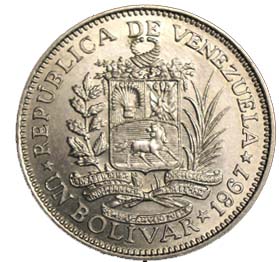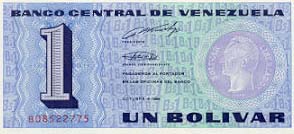|


The bolivar fuerte (plural: bolivares fuertes, ISO 4217 code: VEF; locally abbreviated as Bs. F) is the new currency of Venezuela since 1 January 2008. It is subdivided into 100 centimos and replaced the bolivar (plural: bolivares, ISO 4217 code: VEB; locally abbreviated as Bs.) at the rate of Bs.F 1 = Bs.1000 due to inflation.
History
Bolivar
The bolivar was adopted by the monetary law of 1879, replacing the short-lived venezolano at a rate of 5 bolivares = 1 venezolano. Initially, the bolivar was defined on the silver standard, equal to 4.5 g fine silver, following the principles of the Latin Monetary Union. The monetary law of 1887 made the gold bolivar unlimited legal tender, and the gold standard came into full operation in 1910. Venezuela went off gold in 1930, and in 1934 the bolivar exchange rate was fixed in terms of the U.S. dollar at a rate of 3.914 bolivares = 1 U.S. dollar, revalued to 3.18 bolivares = 1 U.S. dollar in 1937, a rate which lasted until 1941. Until February 18, 1983 (now called Black Friday (Viernes Negro) by many Venezuelans), the bolivar had been the region's most stable and internationally accepted currency. Since then, however, it has fallen prey to high devaluation.
From January 1, 2010, the bolivar was officially pegged to the U.S. dollar at a fixed exchange rate of 2.60 bolivares (type 1) and 4.30 bolivares (type 2) to the dollar by the BCV.
Bolivar fuerte
The government announced on 7 March, 2007 that the bolivar would be revalued at a ratio of 1 to 1000 on 1 January 2008 and renamed the bolivar fuerte in an effort to facilitate the ease of transaction and accounting.The new name is literally translated as "strong bolivar",but also references an old coin called the Peso fuerte worth 10 Spanish reales.
The name "bolivar fuerte" is only used temporarily to distinguish it from the older currency that is being used along with the bolivar fuerte. This duality will last until 2009.
The Central Bank of Venezuela is promoting the new currency with an ad campaign and the slogan: "Una economia fuerte, un bolivar fuerte, un pais fuerte" (lit. "a strong economy, a strong bolivar, a strong country").Nevertheless, the black market value of the bolivar fuerte has been significantly lower than the fixed exchange rate of 2.15 (in February of 2008 it was as high as 7.0 to 1).It is illegal to publish this "parallel exchange rate" in Venezuela.
As of 8 January 2010, the value is being changed by the government from the fixed exchange rate of 2,150 bolivares (2.15 bolivares fuertes) to 2,600 bolivares (2.60 bolivares fuertes) for some imports (certain foods and healthcare goods) and 4,300 bolivares (4.30 bolivares fuertes) for 'unnecessary' imports like cars, petrochemicals, and electronics.
Coins
Bolivar
In 1879, silver coins were introduced in denominations of 1/5, ½, 1, 2, and 5 bolivares, together with gold 20 bolivares. Gold 100 bolivares were also issued between 1886 and 1889. In 1894, silver ¼ bolivar coins were introduced, followed by cupro-nickel 5 and 12½ centimos in 1896.
In 1912, production of gold coins ceased, whilst production of the 5 bolivares ended in 1936. In 1965, nickel replaced silver in the 25 and 50 centimos, with the same happening to the 1 and 2 bolivares in 1967. In 1971, cupro-nickel 10 centimo coins were issued, the 12½ centimos having last been issued in 1958. A nickel 5 bolivares was introduced in 1973. Clad steel (first copper, then nickel and cupro-nickel) was used for the 5 centimos from 1974. Nickel clad steel was introduced for all denominations from 25 centimos up to 5 bolivares in 1989.
In 1998, after a period of high inflation, a new coinage was introduced consisting of 10, 20, 50, 100 and 500 bolivar denominations.
The former coins were:
- 10 bolivares
- 20 bolivares
- 50 bolivares
- 100 bolivares
- 500 bolivares
- 1000 bolivares (introduced in 2006, recalled due to the coins using the old Coat of Arms)
All the coins had the same design. On the obverse the left profile of the Libertador Simon Bolivar is depicted, along with the inscription "Bolivar Libertador" within a heptagon, symbolizing the seven stars of the flag. On the reverse the coat of arms is depicted, circled by the official name of the country, with the date and the denomination below. In 2001, the reverse design was changed, putting the denomination of the coin at the right of the shield of the coat of arms, semicircled by the official name of the country and the year of its emission below.
Bolivar fuerte
Coins are in denominations of 1, 5, 10, 12½, 25, 50 centimos, and 1 bolivar. However, the coin of 1 centimo is not widely used as most prices are rounded up to the next 5 centimos.
Banknotes
Bolivar
In 1940, the Banco Central de Venezuela began issuing paper money, introducing by 1945 denominations of 10, 20, 50, 100 and 500 bolivares. 5 bolivar notes were issued between 1966 and 1974, when they were replaced by coins. In 1989, notes for 1, 2 and 5 bolivares were issued.
As inflation took hold, higher denominations of banknotes started being introduced: 1,000 bolivares in 1991, 2,000 and 5,000 bolivares in 1994, and 10,000, 20,000 and 50,000 bolivares in 1998. The first 20,000 banknotes were made in a green color similar to the one of the 2,000 banknotes, which caused confusion, and new banknotes were made in the new olive green color.
Bolivar fuerte
Banknotes are in denominations of 2, 5, 10, 20, 50 and 100 bolivares.
The text on this page has been made available under the Creative Commons Attribution-ShareAlike License and Creative Commons Licenses
|
